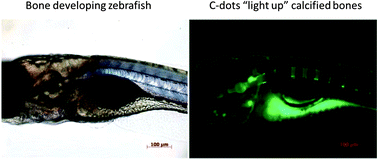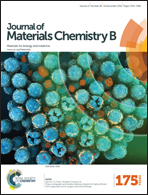“Dark” carbon dots specifically “light-up” calcified zebrafish bones†
Abstract
Because accidents, disease and aging compromise the structural and physiological functions of bones, the development of an in vivo bone imaging test is critical to identify, detect and diagnose bone related development and dysfunctions. Recent advances in fluorescence instrumentation offer a new alternative for traditional bone imaging methods. However, the development of new in vivo bone imaging fluorescence materials has significantly lagged behind. Here we show that carbon dot nanoparticles (C-dots) with low quantum yield (“dark”) bind to calcified bone structures of live zebrafish larvae with high affinity and selectivity. Binding resulted in a strong enhancement of luminescence that was not observed in other tissues, including non-calcified endochondral elements. Retention of C-dots by bones was very stable, long lasting, and with no detectable toxicity. Furthermore, we found C-dots to be a suitable carrier to deliver fluorescein to bones. These observations support a novel and revolutionary use of C-dots as highly specific bioagents for bone imaging and diagnosis, and as bone-specific drug delivery vehicles.


 Please wait while we load your content...
Please wait while we load your content...